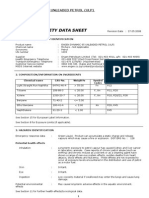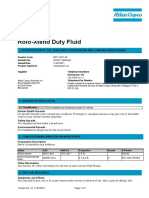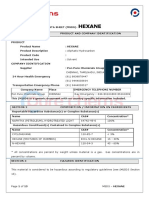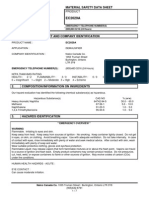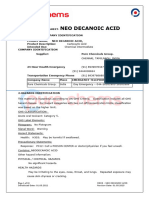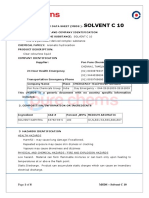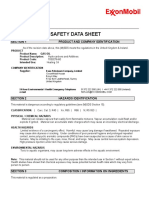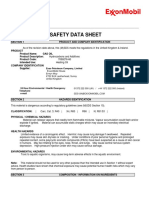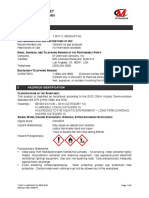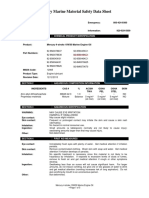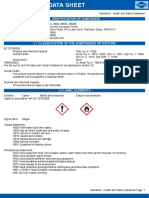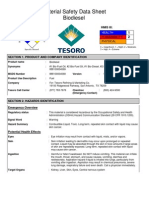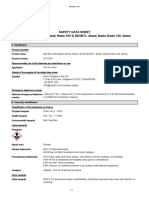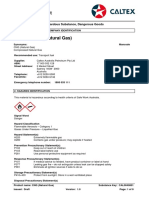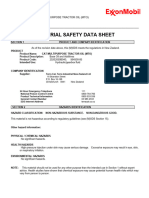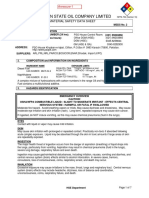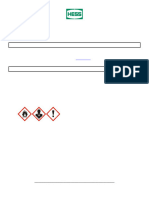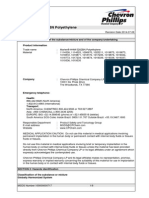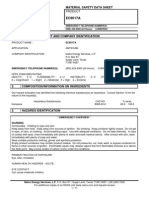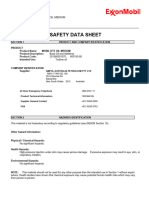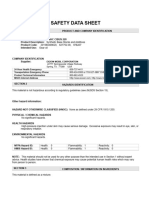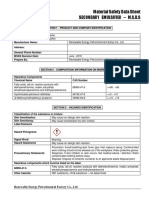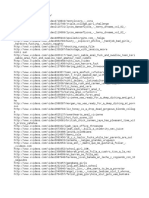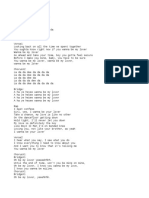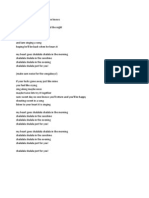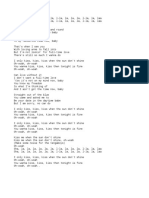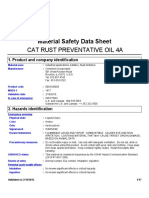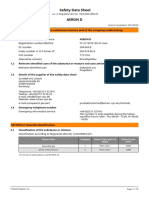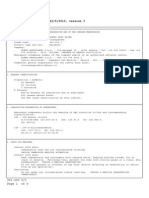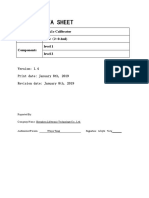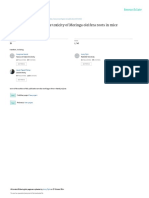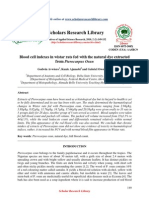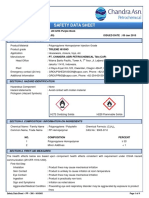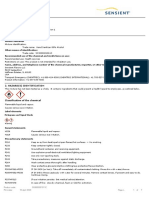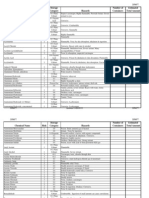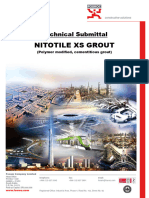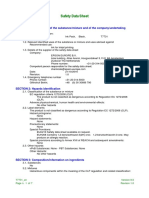Solvent C 9: Page 1 of 15
Solvent C 9: Page 1 of 15
Uploaded by
Elder Andrades MartinezCopyright:
Available Formats
Solvent C 9: Page 1 of 15
Solvent C 9: Page 1 of 15
Uploaded by
Elder Andrades MartinezOriginal Title
Copyright
Available Formats
Share this document
Did you find this document useful?
Is this content inappropriate?
Copyright:
Available Formats
Solvent C 9: Page 1 of 15
Solvent C 9: Page 1 of 15
Uploaded by
Elder Andrades MartinezCopyright:
Available Formats
MATERIAL SAFETY DATA SHEET (MSDS) - SOLVENT C 9
1. PRODUCT AND COMPANY IDENTIFICATION
PRODUCT
Product Name: SOLVENT C 9
Product Description: Aromatic Hydrocarbon
Intended Use: Solvent
COMPANY IDENTIFICATION
Supplier: Pure Chemicals Group.
CHENNAI, TAMILNADU, INDIA
24 Hour Health Emergency (91) 8939878447
(91) 9444038694
Transportation Emergency Phone (91) 8939768680
Company Name Place EMERGENCY TELEPHONE NUMBER
Pure Chemicals Group. India Day Emergency – 044-26161803-26161809
This (M)SDS is a generic document with no country specific information
included.
2. COMPOSITION / INFORMATION ON INGREDIENTS
Reportable Hazardous Substance(s) or Complex Substance(s)
Name CAS# Concentration*
SOLVENT NAPHTHA (PETROLEUM), 64742-95-6 100%
LIGHT AROMATIC
Hazardous Constituent(s) Contained in Complex Substance(s)
Name CAS# Concentration*
CUMENE 98-82-8 < 1.1%
PSEUDOCUMENE (1,2,4- 95-63-6 < 32.0%
TRIMETHYLBENZENE)
XYLENES 1330-20-7 < 2.2%
* All concentrations are percent by weight unless material is a gas. Gas concentrations
are in percent by volume.
3. HAZARDS IDENTIFICATION
This material is considered to be hazardous according to regulatory guidelines (see
Page 1 of 15 MSDS - SOLVENT C 9
(M)SDS Section 15).
POTENTIAL PHYSICAL / CHEMICAL EFFECTS
Combustible. Material can release vapors that readily form flammable mixtures.
Vapor accumulation could flash and/or explode if ignited. Material can
accumulate static charges which may cause an ignition.
POTENTIAL HEALTH EFFECTS
Repeated exposure may cause skin dryness or cracking. If swallowed, may be
aspirated and cause lung damage. May be irritating to the eyes, nose, throat,
and lungs. May be irritating to the respiratory tract - effects are reversible. May
cause central nervous system depression.
ENVIRONMENTAL HAZARDS
Toxic to aquatic organisms, may cause long-term adverse effects in the aquatic
environment.
NFPA Hazard ID: Health: 1 Flammability: 2 Reactivity: 0
HMIS Hazard ID: Health: 1 Flammability: 2 Reactivity: 0
NOTE: This material should not be used for any other purpose than the intended use in
Section 1 without expert advice. Health studies have shown that chemical exposure may
cause potential human health risks which may vary from person to person.
4. FIRST AID MEASURES
Inhalation
Remove from further exposure. For those providing assistance, avoid exposure
to yourself or others. Use adequate respiratory protection. If respiratory
irritation, dizziness, nausea, or unconsciousness occurs, seek immediate medical
assistance. If breathing has stopped, assist ventilation with a mechanical device
or use mouth-to-mouth resuscitation.
SKIN CONTACT
Wash contact areas with soap and water. Remove contaminated clothing.
Launder contaminated clothing before reuse.
EYE CONTACT
Flush thoroughly with water. If irritation occurs, get medical assistance.
Ingestion
Seek immediate medical attention. Do not induce vomiting.
NOTE TO PHYSICIAN
If ingested, material may be aspirated into the lungs and cause chemical
pneumonitis. Treat appropriately.
Page 2 of 15 MSDS - SOLVENT C 9
5. FIRE FIGHTING MEASURES
EXTINGUISHING MEDIA
Appropriate Extinguishing Media: Use water fog, foam, dry chemical or carbon
dioxide (CO2) to extinguish flames.
Inappropriate Extinguishing Media: Straight Streams of Water
FIRE FIGHTING
Fire Fighting Instructions: Evacuate area. Prevent runoff from fire control or
dilution from entering streams, sewers, or drinking water supply. Firefighters
should use standard protective equipment and in enclosed spaces, self-contained
breathing apparatus (SCBA). Use water spray to cool fire exposed surfaces and
to protect personnel.
Unusual Fire Hazards: Vapors are flammable and heavier than air. Vapors may
travel across the ground and reach remote ignition sources causing a flashback
fire danger. Hazardous material. Firefighters should consider protective
equipment indicated in Section 8.
Hazardous Combustion Products: Smoke, Fume, Incomplete combustion
products, Oxides of carbon
FLAMMABILITY PROPERTIES
Flash Point [Method]: >42C (108F) [ ASTM D-56]
Flammable Limits (Approximate volume % in air): LEL: 0.9 UEL: 6.2
Autoignition Temperature: 479°C (894°F)
6. ACCIDENTAL RELEASE MEASURES
NOTIFICATION PROCEDURES
In the event of a spill or accidental release, notify relevant authorities in
accordance with all applicable regulations. US regulations require reporting
releases of this material to the environment which exceed the applicable
reportable quantity or oil spills which could reach any waterway including
intermittent dry creeks. The National Response Center can be reached at
(800)424-8802.
PROTECTIVE MEASURES
Avoid contact with spilled material. Warn or evacuate occupants in surrounding
and downwind areas if required due to toxicity or flammability of the material.
See Section 5 for fire fighting information. See the Hazard Identification Section
for Significant Hazards. See Section 4 for First Aid Advice. See Section 8 for
Personal Protective Equipment.
Page 3 of 15 MSDS - SOLVENT C 9
SPILL MANAGEMENT
Land Spill: Eliminate all ignition sources (no smoking, flares, sparks or flames in
immediate area). Stop leak if you can do it without risk. All equipment used
when handling the product must be grounded. Do not touch or walk through
spilled material. Prevent entry into waterways, sewer, basements or confined
areas. A vapor suppressing foam may be used to reduce vapors. Use clean non-
sparking tools to collect absorbed material. Absorb or cover with dry earth, sand
or other non-combustible material and transfer to containers. Large Spills:
Water spray may reduce vapor; but may not prevent ignition in closed spaces.
Recover by pumping or with suitable absorbent.
Water Spill: Stop leak if you can do it without risk. Eliminate sources of ignition.
Warn other shipping. If the Flash Point exceeds the Ambient Temperature by 10
degrees C or more, use containment booms and remove from the surface by
skimming or with suitable absorbents when conditions permit. If the Flash Point
does not exceed the Ambient Air Temperature by at least 10C, use booms as a
barrier to protect shorelines and allow material to evaporate. Seek the advice of
a specialist before using dispersants.
Water spill and land spill recommendations are based on the most likely spill
scenario for this material; however, geographic conditions, wind, temperature,
(and in the case of a water spill) wave and current direction and speed may
greatly influence the appropriate action to be taken. For this reason, local
experts should be consulted. Note: Local regulations may prescribe or limit
action to be taken.
ENVIRONMENTAL PRECAUTIONS
Large Spills: Dike far ahead of liquid spill for later recovery and disposal.
Prevent entry into waterways, sewers, basements or confined areas.
7. HANDLING AND STORAGE
HANDLING
Avoid contact with skin. Potentially toxic/irritating fumes/vapors may be evolved
from heated or agitated material. Use only with adequate ventilation. Prevent
small spills and leakage to avoid slip hazard. Material can accumulate static
charges which may cause an electrical spark (ignition source). Use proper
bonding and/or ground procedures. However, bonding and grounds may not
eliminate the hazard from static accumulation. Consult local applicable standards
for guidance. Additional references include American Petroleum Institute 2003
(Protection Against Ignitions Arising out of Static, Lightning and Stray Currents)
Page 4 of 15 MSDS - SOLVENT C 9
or National Fire Protection Agency 77 (Recommended Practice on Static
Electricity) or CENELEC CLC/TR 50404 (Electrostatics - Code of practice for the
avoidance of hazards due to static electricity).
Loading/Unloading Temperature: [Ambient]
Transport Temperature: [Ambient]
Transport Pressure: [Ambient]
Static Accumulator: This material is a static accumulator. A liquid is typically
considered a nonconductive, static accumulator if its conductivity is below 100
pS/m (100x10E-12 Siemens per meter) and is considered a semiconductive,
static accumulator if its conductivity is below 10,000 pS/m. Whether a liquid is
nonconductive or semiconductive, the precautions are the same. A number of
factors, for example liquid temperature, presence of contaminants, anti-static
additives and filtration can greatly influence the conductivity of a liquid.
STORAGE
The container choice, for example storage vessel, may effect static accumulation
and dissipation. Keep container closed. Handle containers with care. Open slowly
in order to control possible pressure release. Store in a cool, well-ventilated
area. Storage containers should be grounded and bonded. Fixed storage
containers, transfer containers and associated equipment should be grounded and
bonded to prevent accumulation of static charge.
Storage Temperature: [Ambient]
Storage Pressure: [Ambient]
Suitable Containers/Packing: Railcars; Tank Trucks; Barges; Drums; Tankers
Suitable Materials and Coatings (Chemical Compatibility): Carbon Steel;
Stainless Steel; Copper Bronze; Inorganic Zinc Coatings; Epoxy Phenolic;
Polyamide Epoxy; Amine Epoxy; Viton
Unsuitable Materials and Coatings: Vinyl Coatings; Butyl Rubber; Natural
Rubber; Ethylene-proplyene-diene monomer (EPDM); Polyethylene; Polystyrene;
Polypropylene; PVC; Polyacrylonitrile
8. EXPOSURE CONTROLS / PERSONAL PROTECTION
EXPOSURE LIMIT VALUES
Exposure limits/standards (Note: Exposure limits are not additive)
Source Form Limit / Standard NOTE Sourc
e
CUMENE TWA 245 50 ppm Skin OSHA
Page 5 of 15 MSDS - SOLVENT C 9
mg/m3 Z1
CUMENE TWA 50 ppm N/A ACGIH
PSEUDOCUMENE (1,2,4- TWA 25 ppm N/A ACGIH
TRIMETHYLBENZENE)
SOLVENT NAPHTHA Vapor. RCP - 19 ppm 100 Total Exxon
(PETROLEUM), LIGHT TWA mg/m3 Hydrocar Mobil
AROMATIC bons
XYLENES TWA 435 100 ppm N/A OSHA
mg/m3 Z1
XYLENES STEL 150 ppm N/A ACGIH
XYLENES TWA 100 ppm N/A ACGIH
NOTE: Limits/standards shown for guidance only. Follow applicable regulations.
ENGINEERING CONTROLS
The level of protection and types of controls necessary will vary depending upon
potential exposure conditions. Control measures to consider:
Adequate ventilation should be provided so that exposure limits are not
exceeded. Use explosion-proof ventilation equipment.
PERSONAL PROTECTION
Personal protective equipment selections vary based on potential exposure
conditions such as applications, handling practices, concentration and ventilation.
Information on the selection of protective equipment for use with this material, as
provided below, is based upon intended, normal usage.
Respiratory Protection: If engineering controls do not maintain airborne
contaminant concentrations at a level which is adequate to protect worker health,
an approved respirator may be appropriate. Respirator selection, use, and
maintenance must be in accordance with regulatory requirements, if applicable.
Types of respirators to be considered for this material include:
Half-face filter respirator
For high airborne concentrations, use an approved supplied-air respirator,
operated in positive pressure mode. Supplied air respirators with an escape
bottle may be appropriate when oxygen levels are inadequate, gas/vapor warning
properties are poor, or if air purifying filter capacity/rating may be exceeded.
Hand Protection: Any specific glove information provided is based on published
literature and glove manufacturer data. Glove suitability and breakthrough time
will differ depending on the specific use conditions. Contact the glove
manufacturer for specific advice on glove selection and breakthrough times for
your use conditions. Inspect and replace worn or damaged gloves. The types of
Page 6 of 15 MSDS - SOLVENT C 9
gloves to be considered for this material include:
If prolonged or repeated contact is likely, chemical resistant gloves are
recommended. If contact with forearms is likely, wear gauntlet style
gloves.
Eye Protection: If contact is likely, safety glasses with side shields are
recommended.
Skin and Body Protection: Any specific clothing information provided is based
on published literature or manufacturer data. The types of clothing to be
considered for this material include:
If prolonged or repeated contact is likely, chemical, and oil resistant
clothing is recommended.
Specific Hygiene Measures: Always observe good personal hygiene measures,
such as washing after handling the material and before eating, drinking, and/or
smoking. Routinely wash work clothing and protective equipment to remove
contaminants. Discard contaminated clothing and footwear that cannot be
cleaned. Practice good housekeeping.
ENVIRONMENTAL CONTROLS
See Sections 6, 7, 12, 13.
9. PHYSICAL AND CHEMICAL PROPERTIES
Typical physical and chemical properties are given below. Consult the Supplier in
Section 1 for additional data.
GENERAL INFORMATION
Physical State : Liquid
Form : Clear
Color : Colorless
Odor : Aromatic
Odor Threshold : N/D
IMPORTANT HEALTH, SAFETY, AND ENVIRONMENTAL INFORMATION
Relative Density (at 15.6 C) : 0.874
Density (at 15 ºC) : 873 kg/m³ (7.29 lbs/gal, 0.87 kg/dm³)
Flash Point [Method] : >42C (108F) [ ASTM D-56]
Flammable Limits (Approximate volume % in air): LEL: 0.9 UEL: 6.2
Autoignition Temperature : 479°C (894°F)
Boiling Point / Range : 161C (322F) - 171C (340F)
Vapor Density (Air = 1) : 4.2 at 101 kPa
Page 7 of 15 MSDS - SOLVENT C 9
Vapor Pressure : 0.262 kPa (1.97 mm Hg) at 20 C |
0.815 kPa (6.13 mm Hg) at 38C
Evaporation Rate (n-butyl acetate = 1): 0.27
pH : N/A
Log Pow (n-Octanol/Water Partition Coefficient): N/D
Solubility in Water : Negligible
Viscosity : 0.75 cSt (0.75 mm2/sec) at 40 C |
0.9 cSt (0.9 /smm2ec) at 25C
Oxidizing Properties : See Hazards Identification Section.
OTHER INFORMATION
Freezing Point : -14°C (7°F)
Melting Point : N/D
Molecular Weight : 121
Hygroscopic : No
Coefficient of Thermal Expansion : 0.00085 V/VDEGC
10. STABILITY AND REACTIVITY
STABILITY : Material is stable under normal conditions.
CONDITIONS TO AVOID: Avoid heat, sparks, open flames and other ignition sources.
MATERIALS TO AVOID : Strong oxidizers, Nitric acid, Sulfuric acid
HAZARDOUS DECOMPOSITION PRODUCTS: Material does not decompose at ambient
temperatures.
HAZARDOUS POLYMERIZATION: Will not occur.
11. TOXICOLOGICAL INFORMATION
ACUTE TOXICITY
Route of Exposure Conclusion / Remarks
Inhalation
Toxicity: Data available. Minimally Toxic. Based on test data for the material.
Irritation: Data available. Elevated temperatures or mechanical action may
form vapors, mist, or fumes which may be irritating
to the eyes, nose, throat, or lungs. Based on test
data for structurally similar materials.
Ingestion
Toxicity: LD50 > 3000 mg/kg Minimally Toxic. Based on test data for structurally
Page 8 of 15 MSDS - SOLVENT C 9
similar materials.
Skin
Toxicity: LD50 > 3160 mg/kg Minimally Toxic. Based on test data for the material.
Irritation: Data available. Mildly irritating to skin with prolonged exposure.
Based on test data for the material.
Eye
Irritation: Data available. May cause mild, short-lasting discomfort to eyes.
Based on test data for the material.
CHRONIC/OTHER EFFECTS
For the product itself:
Vapor/aerosol concentrations above recommended exposure levels are irritating
to the eyes and respiratory tract, may cause headaches, dizziness, anesthesia,
drowsiness, unconsciousness and other central nervous system effects including
death.
Prolonged and/or repeated skin contact with low viscosity materials may defat the
skin resulting in possible irritation and dermatitis.
Small amounts of liquid aspirated into the lungs during ingestion or from vomiting
may cause chemical pneumonitis or pulmonary edema.
Contains:
CUMENE: Repeated inhalation exposure of cumene vapor produced damage in
the kidney of male rats only. These effects are believed to be species specific and
are not relevant to humans.
Additional information is available by request.
The following ingredients are cited on the lists below: None.
--REGULATORY LISTS SEARCHED--
1 = NTP CARC 3 = IARC 1 5 = IARC 2B
2 = NTP SUS 4 = IARC 2A 6 = OSHA CARC
12. ECOLOGICAL INFORMATION
The information given is based on data available for the material, the components of the
material, and similar materials.
ECOTOXICITY
Material -- Expected to be toxic to aquatic organisms. May cause long-term
adverse effects in the aquatic environment.
MOBILITY
Material -- Highly volatile, will partition rapidly to air. Not expected to partition
Page 9 of 15 MSDS - SOLVENT C 9
to sediment and waste water solids.
PERSISTENCE AND DEGRADABILITY
Biodegradation:
Material -- Expected to be readily biodegradable.
Hydrolysis:
Material -- Transformation due to hydrolysis not expected to be significant.
Photolysis:
Material -- Transformation due to photolysis not expected to be significant.
Atmospheric Oxidation:
Material -- Expected to degrade rapidly in air
OTHER ECOLOGICAL INFORMATION
VOC (EPA Method 24): 7.294 lbs/gal
13. DISPOSAL CONSIDERATIONS
Disposal recommendations based on material as supplied. Disposal must be in
accordance with current applicable laws and regulations, and material characteristics at
time of disposal.
DISPOSAL RECOMMENDATIONS
Product is suitable for burning in an enclosed controlled burner for fuel value or
disposal by supervised incineration at very high temperatures to prevent
formation of undesirable combustion products.
REGULATORY DISPOSAL INFORMATION
RCRA Information: Disposal of unused product may be subject to RCRA
regulations (40 CFR 261). Disposal of the used product may also be regulated
due to ignitability, corrosivity, reactivity or toxicity as determined by the Toxicity
Characteristic Leaching Procedure (TCLP). Potential RCRA characteristics:
IGNITABILITY.
Empty Container Warning Empty Container Warning (where applicable): Empty
containers may contain residue and can be dangerous. Do not attempt to refill or clean
containers without proper instructions. Empty drums should be completely drained and
safely stored until appropriately reconditioned or disposed. Empty containers should be
taken for recycling, recovery, or disposal through suitably qualified or licensed contractor
and in accordance with governmental regulations. DO NOT PRESSURISE, CUT, WELD,
BRAZE, SOLDER, DRILL, GRIND, OR EXPOSE SUCH CONTAINERS TO HEAT, FLAME,
SPARKS, STATIC ELECTRICITY, OR OTHER SOURCES OF IGNITION. THEY MAY EXPLODE
AND CAUSE INJURY OR DEATH.
Page 10 of 15 MSDS - SOLVENT C 9
14. TRANSPORT INFORMATION
LAND (DOT)
Proper Shipping Name : PETROLEUM DISTILLATES, N.O.S.
Hazard Class & Division : COMBUSTIBLE LIQUID
ID Number : 1268
Packing Group : III
Product RQ : 4545.45 LBS - XYLENES
ERG Number : 128
Label(s) : NONE
Transport Document Name: UN1268, PETROLEUM DISTILLATES, N.O.S.,
COMBUSTIBLE LIQUID, PG III, RQ (Xylenes)
Footnote: The flash point of this material is greater than 100 F. Regulatory
classification of this material varies. DOT: Flammable liquid or combustible liquid.
OSHA: Combustible liquid. IATA/IMO: Flammable liquid. This material is not
regulated under 49 CFR in a container of 119 gallon capacity or less when
transported solely by land, as long as the material is not a hazardous waste, a
marine pollutant, or specifically listed as a hazardous substance.
LAND (TDG)
Proper Shipping Name: PETROLEUM DISTILLATES, N.O.S.
Hazard Class & Division: 3
UN Number: 1268
Packing Group: III
SEA (IMDG)
Proper Shipping Name: PETROLEUM DISTILLATES, N.O.S.
Hazard Class & Division: 3
EMS Number: F-E, S-E
UN Number: 1268
Packing Group: III
Label(s): 3
Transport Document Name: UN1268, PETROLEUM DISTILLATES, N.O.S., 3, PG
III, (42°C c.c.)
Footnote: This material is not classified as a marine pollutant according to the
criteria presented in Chapter 2.9 of the IMDG code (H401 Only).
AIR (IATA)
Proper Shipping Name : PETROLEUM DISTILLATES, N.O.S.
Hazard Class & Division : 3 LAND (TDG)
Proper Shipping Name : PETROLEUM DISTILLATES, N.O.S.
Page 11 of 15 MSDS - SOLVENT C 9
Hazard Class & Division : 3
UN Number : 1268
Packing Group : III
SEA (IMDG)
Proper Shipping Name : PETROLEUM DISTILLATES, N.O.S.
Hazard Class & Division : 3
EMS Number : F-E, S-E
UN Number : 1268
Packing Group : III
Label(s) : 3
Transport Document Name : UN1268, PETROLEUM DISTILLATES, N.O.S., 3,
PG III, (42°C c.c.)
Footnote: This material is not classified as a marine pollutant according to the
criteria presented in Chapter 2.9 of the IMDG code (H401 Only).
AIR (IATA)
Proper Shipping Name : PETROLEUM DISTILLATES, N.O.S.
Hazard Class & Division : 3
UN Number: 1268
Packing Group: III
Label(s) / Mark(s): 3
Transport Document Name: UN1268, PETROLEUM DISTILLATES, N.O.S., 3, PG
III
15. REGULATORY INFORMATION
OSHA HAZARD COMMUNICATION STANDARD: When used for its intended purpose, this
material is classified as hazardous in accordance with OSHA 29CFR 1910.1200.
NATIONAL CHEMICAL INVENTORY LISTING: AICS, IECSC, DSL, EINECS, ENCS, KECI,
PICCS, TSCA
EPCRA: This material contains no extremely hazardous substances.
CERCLA: This material is not subject to any special reporting under the requirements of
the Comprehensive Environmental Response, Compensation and Liability Act (CERCLA).
Contact local authorities to determine if other reporting requirements apply.
CERCLA: CAS Number Typical Value Component RQ Product
Chemical Name RQ
CUMENE 98-82-8 < 1.1% 5000 LBS 454545.45
LBS
Page 12 of 15 MSDS - SOLVENT C 9
XYLENES 1330-20-7 < 2.2% 100 LBS 4545.45
LBS
CWA / OPA: This product is classified as an oil under Section 311 of the Clean Water
Act (40 CFR 110) and the Oil Pollution Act of 1990. Discharge or spills which produce a
visible sheen on either surface water, or in waterways/sewers which lead to surface
water, must be reported to the National Response Center at 800-424-8802.
SARA (311/312) REPORTABLE HAZARD CATEGORIES: Fire. Delayed Health.
SARA (313) TOXIC RELEASE INVENTORY:
Chemical Name CAS Number Typical Value
CUMENE 98-82-8 < 1.1%
PSEUDOCUMENE (1,2,4- 95-63-6 < 32%
TRIMETHYLBENZENE)
XYLENES 1330-20-7 < 2.2%
The following ingredients are cited on the lists below:
Chemical Name CAS Number List Citations
CUMENE 98-82-8 1, 4, 13, 16, 17, 18, 19
PSEUDOCUMENE (1,2,4- 95-63-6 1, 13, 16, 17, 18, 19
TRIMETHYLBENZENE)
XYLENES 1330-20-7 1, 4, 5, 9, 13, 15, 16, 17,
18, 19
--REGULATORY LISTS SEARCHED--
1 = ACGIH ALL 6 = TSCA 5a2 11 = CA P65 REPRO 16 = MN RTK
2 = ACGIH A1 7 = TSCA 5e 12 = CA RTK 17 = NJ RTK
3 = ACGIH A2 8 = TSCA 6 13 = IL RTK 18 = PA RTK
4 = OSHA Z 9 = TSCA 12b 14 = LA RTK 19 = RI RTK
5 = TSCA 4 10 = CA P65 CARC 15 = MI 293
Code key: CARC=Carcinogen; REPRO=Reproductive
16. OTHER INFORMATION
N/D = Not determined, N/A = Not applicable
THIS SAFETY DATA SHEET CONTAINS THE FOLLOWING REVISIONS:
Revision Changes:
Page 13 of 15 MSDS - SOLVENT C 9
Section 07: Handling and Storage - Storage Phrases was modified.
PRECAUTIONARY LABEL TEXT:
Contains: SOLVENT NAPHTHA (PETROLEUM), LIGHT AROMATIC
CAUTION!
HEALTH HAZARDS
Repeated exposure may cause skin dryness or cracking. If swallowed, may be aspirated
and cause lung damage.
PHYSICAL HAZARDS
Combustible. Material can accumulate static charges which may cause an ignition.
PRECAUTIONS
Avoid contact with skin. Potentially toxic/irritating fumes/vapors may be evolved from
heated or agitated material. Use only with adequate ventilation. Use proper bonding
and/or ground procedures. However, bonding and grounds may not eliminate the
hazard from static accumulation.
FIRST AID
Inhalation: Remove from further exposure. For those providing assistance, avoid
exposure to yourself or others. Use adequate respiratory protection. If respiratory
irritation, dizziness, nausea, or unconsciousness occurs, seek immediate medical
assistance. If breathing has stopped, assist ventilation with a mechanical device or use
mouth-to-mouth resuscitation.
Eye: Flush thoroughly with water. If irritation occurs, get medical assistance.
Oral: Seek immediate medical attention. Do not induce vomiting.
Skin: Wash contact areas with soap and water. Remove contaminated clothing.
Launder contaminated clothing before reuse.
FIRE FIGHTING MEDIA
Use water fog, foam, dry chemical or carbon dioxide (CO2) to extinguish flames.
SPILL/LEAK
Land Spill: Eliminate all ignition sources (no smoking, flares, sparks or flames in
immediate area). Stop leak if you can do it without risk. Prevent entry into waterways,
sewer, basements or confined areas. A vapor suppressing foam may be used to reduce
vapors. Absorb or cover with dry earth, sand or other non-combustible material and
transfer to containers. Recover by pumping or with suitable absorbent.
Water Spill: Stop leak if you can do it without risk. Eliminate sources of ignition. Warn
other shipping. If the Flash Point exceeds the Ambient Temperature by 10 degrees C or
more, use containment booms and remove from the surface by skimming or with
suitable absorbents when conditions permit. If the Flash Point does not exceed the
Ambient Air Temperature by at least 10C, use booms as a barrier to protect shorelines
Page 14 of 15 MSDS - SOLVENT C 9
and allow material to evaporate. Seek the advice of a specialist before using
dispersants.
This warning is given to comply with California Health and Safety Code 25249.6 and
does not constitute an admission or a waiver of rights. This product contains a chemical
known to the State of California to cause cancer.
Disclaimer:
The information and recommendations contained herein are, to the best of Pure
Chemicals Group knowledge and belief, accurate and reliable as of the date issued.
You can contact Pure Chemicals Group to ensure that this document is the most
current available from Pure Chemicals Group. The information and recommendations
are offered for the user's consideration and examination. It is the user's responsibility to
satisfy itself that the product is suitable for the intended use. If buyer repackages this
product, it is the user's responsibility to insure proper health, safety and other necessary
information is included with and/or on the container. Appropriate warnings and safe-
handling procedures should be provided to handlers and users. Alteration of this
document is strictly prohibited. Except to the extent required by law, re-publication or
retransmission of this document, in whole or in part, is not permitted.
Page 15 of 15 MSDS - SOLVENT C 9
You might also like
- Safety Data Sheet: Chevron (Philippines) Diesel Fuel OilDocument8 pagesSafety Data Sheet: Chevron (Philippines) Diesel Fuel OilRenalyn TorioNo ratings yet
- Engen Dynamic 95 Unleaded Petrol (Ulp)Document9 pagesEngen Dynamic 95 Unleaded Petrol (Ulp)timbrinNo ratings yet
- Roto-Xtend Duty Fluid: Safety Data SheetDocument7 pagesRoto-Xtend Duty Fluid: Safety Data SheetPEDRO PABLO DUQUENo ratings yet
- Solvent C 9: Solvent Naphtha (Petroleum), Light AromaticDocument14 pagesSolvent C 9: Solvent Naphtha (Petroleum), Light Aromaticpepita purbaNo ratings yet
- Isopar HDocument11 pagesIsopar Hwaxim26322No ratings yet
- Exxsol D95Document9 pagesExxsol D95Elisa Arroyo RodriguezNo ratings yet
- Methyl Ethyl Ketone MSDSDocument15 pagesMethyl Ethyl Ketone MSDSArjunNo ratings yet
- HexaneDocument15 pagesHexanekimuasNo ratings yet
- Exxsol D60Document10 pagesExxsol D60Adi WiraNo ratings yet
- Hexane PDFDocument13 pagesHexane PDFHanif StrongNo ratings yet
- V-Clean 66 SDSDocument11 pagesV-Clean 66 SDSIkhwanHasbullahNo ratings yet
- Demulsifier MSDSDocument7 pagesDemulsifier MSDSfructoraNo ratings yet
- Neo Decanoic Acid MSDSDocument10 pagesNeo Decanoic Acid MSDSsenthilkumar.sNo ratings yet
- Solvent C 10Document8 pagesSolvent C 10Elder Andrades MartinezNo ratings yet
- Diesel MSDSDocument9 pagesDiesel MSDSgabinuangNo ratings yet
- Gas Oil MsdsDocument10 pagesGas Oil MsdsWilson WanNo ratings yet
- Sherwin Williams Matt Varnish SDSDocument6 pagesSherwin Williams Matt Varnish SDSJoe de Tracy GouldNo ratings yet
- Safety Data Sheet: Product Name: GAS OILDocument10 pagesSafety Data Sheet: Product Name: GAS OILJustice MachiwanaNo ratings yet
- Escaid 110 Exxon MobileDocument11 pagesEscaid 110 Exxon MobilePatricio Santis CortésNo ratings yet
- 1250 Red MSDSDocument4 pages1250 Red MSDSkwerwaNo ratings yet
- Isopar HDocument10 pagesIsopar HFernando HarahapNo ratings yet
- Safety Data Sheet T-Butyl Mercaptan: 1 IdentificationDocument9 pagesSafety Data Sheet T-Butyl Mercaptan: 1 IdentificationJeremíasNo ratings yet
- Texamatic 1888: Safety Data SheetDocument7 pagesTexamatic 1888: Safety Data Sheethoussem houssemNo ratings yet
- Mercury 4t Oil MSDSDocument5 pagesMercury 4t Oil MSDSCelesNo ratings yet
- Safety Data Sheet: Chevron (Singapore) Diesel Gas OilDocument8 pagesSafety Data Sheet: Chevron (Singapore) Diesel Gas OilWalter NativoNo ratings yet
- Safety Data Sheet: Chevron (Singapore) Diesel Gas OilDocument8 pagesSafety Data Sheet: Chevron (Singapore) Diesel Gas OilMaza LufiasNo ratings yet
- 1 Thinner MSDSDocument10 pages1 Thinner MSDSLoveNo ratings yet
- Eng Msds SHL Edm 32 (Re11)Document6 pagesEng Msds SHL Edm 32 (Re11)duyvuNo ratings yet
- Cetus de 100 UsDocument6 pagesCetus de 100 UsAustin UdofiaNo ratings yet
- Minimum Oil Circuit BreakerDocument4 pagesMinimum Oil Circuit BreakergshdavidNo ratings yet
- Galva FroidDocument7 pagesGalva Froidarun vijayNo ratings yet
- Caltex Delo-Syn-ATF-HD-SDS-37313-1-July-2015Document7 pagesCaltex Delo-Syn-ATF-HD-SDS-37313-1-July-2015AlMarzouk ShivaNo ratings yet
- Pulsalube Ultra 6Hgs Synthetic Hydraulic & Gear Oil: Safety Data SheetDocument10 pagesPulsalube Ultra 6Hgs Synthetic Hydraulic & Gear Oil: Safety Data Sheeteko riyantoNo ratings yet
- MsdsbiodieselDocument10 pagesMsdsbiodieselHafid AlwanNo ratings yet
- Ms Ds BiodieselDocument10 pagesMs Ds BiodieselOsckar DezNo ratings yet
- Diesel Fuel MsdsDocument10 pagesDiesel Fuel Msdsrongo84No ratings yet
- Flash Point Int Green DieselDocument8 pagesFlash Point Int Green DieselAnggya AnggyNo ratings yet
- Safety Data Sheet: Hazardous Substance, Dangerous GoodsDocument8 pagesSafety Data Sheet: Hazardous Substance, Dangerous GoodsRocky RamNo ratings yet
- Safety Data Sheet: Product Name: FCC CATALYSTDocument11 pagesSafety Data Sheet: Product Name: FCC CATALYSTLindsey BondNo ratings yet
- Lsfo MSDS 2021Document8 pagesLsfo MSDS 2021jayson lacuestaNo ratings yet
- MSDS Slack Wax ZistaDocument9 pagesMSDS Slack Wax ZistaAngela CaysipNo ratings yet
- HSD PDFDocument7 pagesHSD PDFsaqibNo ratings yet
- Cat Multipurpose Tractor Oil MtoDocument9 pagesCat Multipurpose Tractor Oil MtoFiorela zavaleta vásquezNo ratings yet
- Exxsol D40 SDSDocument10 pagesExxsol D40 SDSKim Chuan OngNo ratings yet
- Ms Ds NaphthaDocument12 pagesMs Ds NaphthaCatharina Natasa BellaFortunaNo ratings yet
- Annexure-1 PSO HSD MSDSDocument7 pagesAnnexure-1 PSO HSD MSDSMOL Team LeadNo ratings yet
- Diesel Fuels - CleanedDocument10 pagesDiesel Fuels - CleanedAWKNo ratings yet
- SDS CN en PDFDocument8 pagesSDS CN en PDFKhanh Ly Nguyen ThiNo ratings yet
- Antifoam 2 MSDSDocument11 pagesAntifoam 2 MSDSfructoraNo ratings yet
- 015 Mineral TurpentineDocument8 pages015 Mineral TurpentineLucaNo ratings yet
- MSDS 15W40Document4 pagesMSDS 15W40Sukhjeet SinghNo ratings yet
- Ms Ds Detail PageDocument9 pagesMs Ds Detail PageCarlos GuashcoNo ratings yet
- MSDS 743443Document9 pagesMSDS 743443taskmastrNo ratings yet
- Mobil Shc Cibus 220 SdsDocument9 pagesMobil Shc Cibus 220 SdsLxsNo ratings yet
- MSDS-Secondary EmulsifierDocument6 pagesMSDS-Secondary EmulsifierrubayanNo ratings yet
- Tmah SDSDocument6 pagesTmah SDSCheNo ratings yet
- Guidelines For Open Plant StructuresDocument6 pagesGuidelines For Open Plant StructuresIndrawNo ratings yet
- Dust Explosion and Fire Prevention Handbook: A Guide to Good Industry PracticesFrom EverandDust Explosion and Fire Prevention Handbook: A Guide to Good Industry PracticesNo ratings yet
- After a Disaster - Information to Help You and Your Family RecoverFrom EverandAfter a Disaster - Information to Help You and Your Family RecoverNo ratings yet
- ScenesDocument1 pageScenesElder Andrades MartinezNo ratings yet
- La Bouche - Be My LoverDocument1 pageLa Bouche - Be My LoverElder Andrades MartinezNo ratings yet
- ThereDocument1 pageThereDg HasmahNo ratings yet
- Vengaboys - KissDocument1 pageVengaboys - KissElder Andrades MartinezNo ratings yet
- Denatured Fuel Ethanol: Material Safety Data SheetDocument14 pagesDenatured Fuel Ethanol: Material Safety Data SheetElder Andrades MartinezNo ratings yet
- Solvent C 10Document8 pagesSolvent C 10Elder Andrades MartinezNo ratings yet
- 4a Rust Preventive OilDocument17 pages4a Rust Preventive OilBalaji DDNo ratings yet
- AERON - D GB enDocument12 pagesAERON - D GB enMuhammad Dzikri AjauhariNo ratings yet
- Safety Data Sheet Boero Grey Water Safety Data Sheet Dated 22/9/2010, Version 3Document6 pagesSafety Data Sheet Boero Grey Water Safety Data Sheet Dated 22/9/2010, Version 3talabizNo ratings yet
- MSDS-HbA1c Calibrator-2019-非危-1.4Document7 pagesMSDS-HbA1c Calibrator-2019-非危-1.4laboratorium rsst klatenNo ratings yet
- Naturist Sıvı El Ve Cilt Dezenfektanı - MSDS - ENGDocument10 pagesNaturist Sıvı El Ve Cilt Dezenfektanı - MSDS - ENGMuzaffer AltayNo ratings yet
- Ecotoxicology, The History and Present Direction (Document9 pagesEcotoxicology, The History and Present Direction (Gonzalo Martínez ParadaNo ratings yet
- Emal 10G MsdsDocument6 pagesEmal 10G MsdstopguitarNo ratings yet
- Phytochemicals and Acute Toxicity of Moringa OleifDocument6 pagesPhytochemicals and Acute Toxicity of Moringa OleifSalman Alfarisy GaulNo ratings yet
- Hematology of RatDocument4 pagesHematology of RatTunde LamidiNo ratings yet
- ChloviewDocument6 pagesChloviewUGOCHUKWUNo ratings yet
- SDS PP 306 Hi10ho PDFDocument4 pagesSDS PP 306 Hi10ho PDFFitra Isni RositaNo ratings yet
- MSDS For Sensientflavors-Hand-Sanitizer-SdsDocument7 pagesMSDS For Sensientflavors-Hand-Sanitizer-SdsTony ScottNo ratings yet
- Bromine HandlingDocument5 pagesBromine HandlingYogesh DhekaleNo ratings yet
- High - RiskDocument50 pagesHigh - RiskjovanivanNo ratings yet
- Nitotile XS GroutDocument33 pagesNitotile XS GroutAhmad SamyNo ratings yet
- 008 Some Heavy Metals Residues in Chicken Meat and Their EdiDocument9 pages008 Some Heavy Metals Residues in Chicken Meat and Their EdiSana AsifNo ratings yet
- SHO Module 3Document19 pagesSHO Module 3Chin Bing100% (1)
- Lit Review WeldingDocument9 pagesLit Review Welding666667No ratings yet
- 2K Sealing Adhesive SX1 Comp B 2.0 SDS - EngDocument6 pages2K Sealing Adhesive SX1 Comp B 2.0 SDS - EngOscar MorenoNo ratings yet
- Neoflo 1-58: Olefin & Paraffin Drilling FluidsDocument4 pagesNeoflo 1-58: Olefin & Paraffin Drilling FluidsLê CôngNo ratings yet
- Business Ethics Data For SilverstarDocument6 pagesBusiness Ethics Data For Silverstarcloi032100% (1)
- Sher Kem / RedDocument17 pagesSher Kem / RedjimmyNo ratings yet
- HLTC 24Document5 pagesHLTC 24elmaNo ratings yet
- Philips Respironics Update On Pe Pur Testing Results and Conclusions Available To Date 20230516Document45 pagesPhilips Respironics Update On Pe Pur Testing Results and Conclusions Available To Date 20230516AVINASHNo ratings yet
- Safety Data Sheet: SECTION 1: Identification of The Substance/mixture and of The Company/undertakingDocument7 pagesSafety Data Sheet: SECTION 1: Identification of The Substance/mixture and of The Company/undertakingforzibNo ratings yet
- PX 3495 - 302637 - SDS - VN - en - MAR-24-2023Document9 pagesPX 3495 - 302637 - SDS - VN - en - MAR-24-2023Yohanes Nico Prabowo MarpaungNo ratings yet
- 005-W0136 British Paints Exterior Varnish Gloss Spraypack: Safety Data SheetDocument9 pages005-W0136 British Paints Exterior Varnish Gloss Spraypack: Safety Data SheetFariza SiswantiNo ratings yet
- CUDA APP 1000 Jet Spray Wash Detergent 12-5-16 MSDS PDFDocument5 pagesCUDA APP 1000 Jet Spray Wash Detergent 12-5-16 MSDS PDFYoutube For EducationNo ratings yet
- Safety in Academic Chemistry Laboratories StudentsDocument48 pagesSafety in Academic Chemistry Laboratories Studentsapi-266788121No ratings yet
- Pera Saw Jigsaw PortableDocument7 pagesPera Saw Jigsaw PortablealexaserafimidesNo ratings yet

